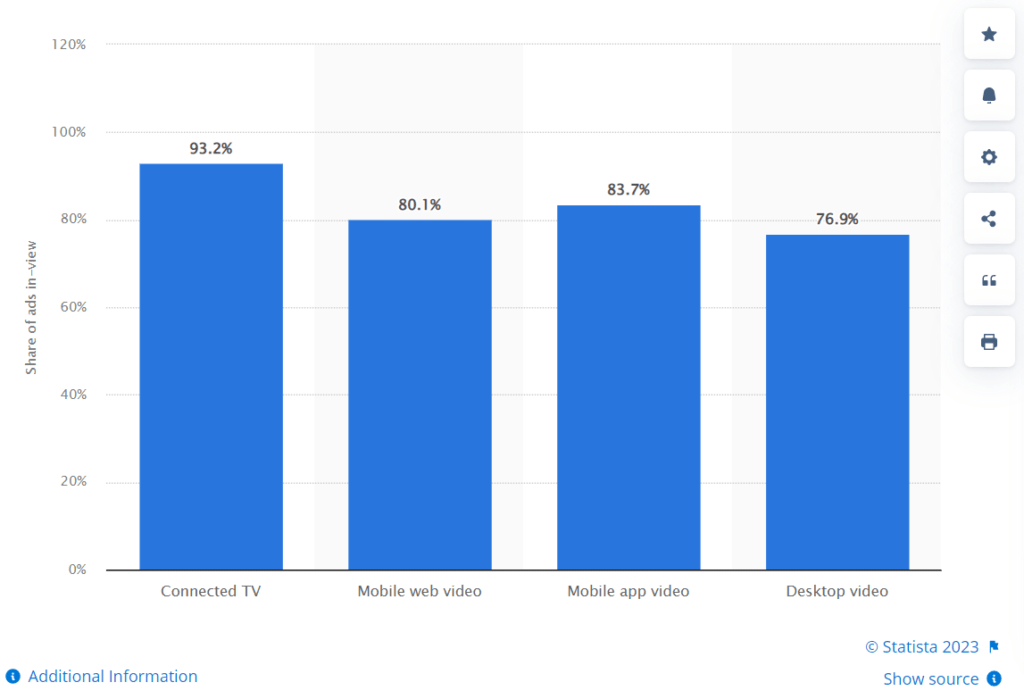In today’s digital age, mobile video advertising has become essential to any successful marketing campaign. Keep reading to learn all about the Mobile Video Advertising, how you can use it, best practices, and examples.
With billions of people worldwide using smartphones and tablets to consume media, mobile video advertising provides a powerful way to reach and engage audiences wherever they are.
- In 2022, online video ad spending amounted to $75 billion, the United States is the country with the highest spending on digital video ads, followed by China and the United Kingdom. (Source: Statista)
- According to a report, 59% of marketers said that video marketing showed a positive ROI, and 58% plan to invest more in videos ads in the future. (Source: Entrepreneur)

But what is mobile video advertising, exactly?
In simple terms, it involves creating and sharing video ads that are optimized for mobile devices.
These ads can be displayed on social media platforms, mobile apps, and websites and are designed to capture viewers’ attention and encourage them to take action.
Why is mobile video advertising so important?
For one thing, mobile devices have become the primary way that people access the internet. It means that if you’re not using mobile video advertising to reach your target audience, you’re missing out on a huge opportunity to connect with potential customers.
See this recent update:
Liftoff, the leading growth acceleration platform for the mobile industry, shared its fifth annual Mobile Ad Creative Index report. The report talks about the five key trends of finance, gaming, e-commerce, entertainment, and dating & social.
According to their report, the longer video ads have proven more effective than other options. As per the analysis, adding a video that is between 31-60 seconds long help in revenue and performance gains.
Also, playable ads proved to be the most cost-effective option to generate revenue from the gaming app installs. Native ads were also a good option mainly for entertainment. But playable ads delivers the best cost per install (CPI) at $1.31 from all the ad formats for gaming, making them an attractive video ad format for publishers and marketers. (Source: Martechseries)
We will provide a complete guide to mobile video advertising. So, let’s explore the exciting world of mobile video advertising!
Also Read: Types of Video Ads, Best Practices & How Are They Served
The Basics of Mobile Video Advertising
Mobile video advertising is a digital marketing strategy that involves creating and sharing video ads optimized for mobile devices. These ads can be displayed on social media platforms, mobile apps, and websites and are designed to capture viewers’ attention and encourage them to take action.
To understand how mobile video advertising works, it’s helpful to know the basic components of a mobile video ad:
Video Content
The actual video content is the heart of any mobile video ad. It should be engaging, informative, and designed to appeal to your target audience.
Call-To-Action (CTA)
A CTA is a message that tells viewers what you want them to do next. It might include clicking a button, filling out a form, speaking to an inbound call centre or visiting your website.

Targeting
Targeting refers to selecting the right audience for your mobile video ads. It might involve selecting specific demographics, locations, interests, or behaviors to ensure that the right people see your ads.
So why is mobile video advertising so effective? There are a few reasons:
Mobile Devices are Ubiquitous
With billions of people worldwide using smartphones and tablets to consume media, mobile video advertising provides a powerful way to reach and engage audiences wherever they are.
Video is Engaging
Video is a highly engaging format that can capture viewers’ attention and convey information in a way that’s easy to understand and remember.
Mobile Video Ads are Customizable
With the ability to target specific audiences, mobile video ads can be customized to fit your target audience’s unique needs and interests.
Also Check: Best Mobile Ad Sizes & Formats For Increased Viewability
Types of Mobile Video Advertising
When it comes to mobile video advertising, there are several different types of ads you can use to reach your target audience. Here are the most common types of mobile video ads:
In-App Ads
In-app ads are video ads within a mobile app. These ads can be displayed before, during, or after the user interacts with the app and are designed to integrate with the user experience seamlessly.
Social Media Ads
Platforms like Facebook, Instagram, and Snapchat offer a variety of video ad formats that can be displayed to users while scrolling through their feeds. These ads can target specific demographics, interests, and behaviors to ensure the right people see them.
Mobile Video Ads on Websites
Mobile video ads can also be displayed on websites optimized for mobile devices. These ads can be displayed before, during, or after the user interacts with the website’s content and are designed to capture the user’s attention and encourage them to take action.
Outstream Video Ads
Outstream video ads are displayed outside of video content. These ads can be displayed within articles or other content and are designed to be less disruptive than traditional in-stream video ads.
Each type of mobile video ad offers unique advantages and disadvantages, and the type of ad you choose will depend on your marketing goals, target audience, and budget.
Read More: What are Outstream Video Ads and How to Get Started With Them?
Targeting Mobile Video Advertising
One of the key benefits of mobile video advertising is that you get to target specific audiences. By targeting your ads to specific demographics and geographic regions, you can ensure that the right people see your message at the right time.
Here are some of the key strategies for targeting your mobile video advertising:
Demographic Targeting
Demographic targeting involves tailoring your ads to specific demographic groups, such as age, gender, income, and education level. It can help ensure that your ads are seen by the people most likely to be interested in your product or service.
Geographic Targeting
Geographic targeting involves tailoring your ads to specific geographic regions, such as cities, states, or countries. It can help you reach people in areas where your product or service is available.
Behavioral Targeting
Behavioral targeting involves tailoring your ads to specific behaviors, such as search history, browsing behavior, and social media activity. It can help you reach people interested in your product or service based on their online activity.
Contextual Targeting
Contextual targeting involves tailoring your ads to the context in which they’re displayed. For example, if you’re advertising a travel product, you may want to target your ads to websites and apps related to travel or vacations.
Combining these targeting strategies allows you to create highly effective mobile video advertising campaigns that reach the right people with the right message.
Creating Effective Mobile Video Ads
Creating effective mobile video ads requires careful attention to the elements that make up a successful advertising campaign. Here are the key elements to consider when creating mobile video ads:
Attention-Grabbing Visuals
One of the most important elements of any video ad is the visuals. Mobile video ads must be visually engaging and attention-grabbing to capture the viewer’s attention. It can be achieved through eye-catching graphics, animation, or live-action footage.
Clear Messaging
Another important element of mobile video ads is clear messaging. The messaging should be clear and concise, conveying the key benefits of the advertised product or service. It’s important to avoid cluttering the ad with too much information, as this can overwhelm viewers.
Strong Call-To-Action
Every mobile video ad should have a strong call-to-action that encourages viewers to take a specific action, such as visiting a website, downloading an app, or purchasing. The call-to-action should be clear and prominent and presented at the right time within the video.
Mobile Optimization
Mobile video ads must be optimized for mobile devices, which means keeping the ad short, minimizing load times, and ensuring the ad is compatible with various devices and platforms.
Testing and Optimization
Finally, testing and optimizing your mobile video ads is important to ensure they are as effective as possible. It may involve A/B testing different versions of the ad to see which performs better or making changes based on feedback from viewers.
Focusing on these key elements can help you create mobile video ads that are engaging, effective, and optimized for mobile devices.
Also Read: Ad Targeting: A Publisher’s Guide (with Pros And Cons)
Best Practices for Mobile Video Advertising
While the specific strategies and tactics used in mobile video advertising will vary depending on the campaign and the target audience, some best practices can help ensure success.
Here are some tips for creating successful mobile video advertising campaigns:
Optimize for Mobile Devices
As we’ve already discussed, optimizing your mobile video ads for mobile devices is essential. It means keeping the ad short, using attention-grabbing visuals, and ensuring it loads quickly and is compatible with various devices and platforms.
Use Data to Inform your Strategy
Data is essential for creating effective mobile video advertising campaigns. By analyzing data on your target audience, you can identify the best channels and tactics to reach them and tailor your messaging and creativity to their interests and behaviors.
Test and Measure Results
Testing and measuring the results of your mobile video ads is essential for understanding what’s working and what’s not. By using A/B testing and other tactics, you can identify the most effective elements of your ad and make adjustments as needed.
Focus on Quality Over Quantity
While reaching a large audience with your mobile video ads is important, it’s even more important to create high-quality ads that resonate with your target audience. Focus on creating a few highly effective ads rather than flooding the market with low-quality ones.
Incorporate Interactivity and Personalization
In today’s digital landscape, consumers expect ads that are personalized and interactive. You can create mobile video ads that stand out and engage viewers by incorporating interactive elements, personalized messaging, and customized calls to action. For example, an AI video translator can help you customize your content and engage the viewers even more, all while reducing both time and costs in the process.
Also Check: In-App Advertising: The Complete Guide
Examples of Successful Mobile Video Advertising
Mobile video advertising has become an increasingly popular form of marketing, and many brands have succeeded with their campaigns.
Here are some examples of successful mobile video advertising campaigns and the strategies they used:
Nike “Dream Crazier”
The Nike “Dream Crazier” campaign is a great example of how to create an impactful and memorable mobile video ad.
The campaign, which focuses on inspiring women to break barriers in sports, uses powerful imagery and inspiring messaging to convey its message.
The video ad, which features female athletes like Serena Williams and Simone Biles, encourages viewers to embrace their dreams and pursue their passions, regardless of what others may think. Its tagline reinforces the ad’s message: “Don’t ask if your dreams are crazy. Ask if they’re crazy enough.”
This ad’s ability to tap into its target audience’s emotions and aspirations makes it so effective. By showing real athletes overcoming challenges and pushing themselves to achieve their goals, the ad inspires viewers to do the same. The ad also uses clear and concise messaging, high-quality visuals, and sound to capture viewers’ attention and keep them engaged.
Apple “Shot on iPhone”
Another successful mobile video advertising campaign is Apple’s “Shot on iPhone” series. The campaign features user-generated content shot on iPhones and showcases the camera’s capabilities in various situations, from everyday moments to stunning landscapes.

The campaign’s success lies in its ability to showcase the iPhone’s features in a relatable and visually stunning way. Using user-generated content, Apple can show real people using their phones to capture moments that matter to them. It highlights the phone’s camera quality and creates a sense of authenticity and relatability that resonates with viewers.
The campaign is also effective because it showcases the product in action without feeling like a traditional advertisement. By focusing on the user’s experience and the product’s capabilities, the campaign feels like a celebration of creativity and individuality rather than a sales pitch.
Amazon “Alexa Loses Her Voice”
The Amazon “Alexa Loses Her Voice” campaign is another successful mobile video advertising example. The campaign features a variety of celebrities, including Gordon Ramsay and Rebel Wilson, taking on the voice of Alexa after she loses her own.

What makes this campaign effective is its use of humor and surprise to capture viewers’ attention. The ad can entertain viewers by featuring unexpected celebrity appearances and playful scenarios while highlighting Alexa’s features and capabilities.
The campaign also uses clear messaging and a strong call to action, encouraging viewers to try out Alexa for themselves. By showcasing the product’s benefits in a fun and engaging way, the ad can convert viewers into customers.
By examining these successful mobile video advertising campaigns, we can see that many approaches can work. Whether tapping into emotions, showcasing product capabilities, or using humor and surprise, the key is creating ads that resonate with the target audience and convey your message clearly and impactfully.
Final Thoughts
Mobile video advertising is an effective and powerful tool for reaching target audiences and driving engagement and conversions. You can create compelling ads that resonate with your audience and drive results by understanding the basics of mobile video advertising, the different types available, how to target specific audiences, and the best practices for creating successful campaigns.
Remember to optimize your ads for mobile devices, use data to inform your campaign strategies, and test and measure results to improve your campaigns continuously.
By following these tips and taking inspiration from successful campaigns in your industry, you can create mobile video advertising that stands out and delivers measurable results.
So, whether you’re an established business or a start-up, mobile video advertising offers an exciting opportunity to reach and engage your target audience. We encourage you to try it out for yourself.
With the right approach and strategy, mobile video advertising can help you achieve your marketing goals and drive growth for your business. Sign up here for more information on mobile video ads.
FAQ
Mobile video advertising uses content to promote a product or service on mobile devices. It typically involves the creation of short, engaging videos designed to capture the attention of mobile users and encourage them to take a desired action, such as making a purchase or downloading an app.
Mobile video advertising is important because it allows brands to reach consumers where they spend a significant amount of their time: on their mobile devices. Mobile video ads can be highly effective at capturing attention and memorably delivering a message, ultimately driving brand awareness, engagement, and conversions.
Some examples of mobile video ads include pre-roll ads (which play before a video), in-stream ads (which play during a video), and native ads (which blend in with the content on a mobile app or website). Other examples include social media ads (such as those on Facebook or Instagram) and interactive ads (such as those that somehow allow users to engage with the ad).
Some best practices for creating effective mobile video ads include keeping the video short (no more than 30 seconds), using attention-grabbing visuals and audio, including a clear call-to-action, and optimizing the video for mobile devices (such as by ensuring it loads quickly and is easily viewable on small screens).
Several metrics can be used to measure the effectiveness of your mobile video ads, including view-through rates (the percentage of viewers who watch the entire ad), click-through rates (the percentage of viewers who click on the ad to learn more or take action), and conversion rates (the percentage of viewers who take the desired action, such as making a purchase or downloading an app). Other metrics include engagement rates (how often users interact with the ad) and cost-per-action (the cost of acquiring a customer or conversion through the ad).
There are several platforms and networks where you can run mobile video ads, including social media platforms like Facebook and Instagram, video-sharing platforms like YouTube and TikTok, and mobile advertising networks like Google AdMob and Unity Ads. The right platform for your ad will depend on your goals, target audience, and budget.








